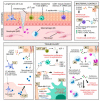Nanomaterial-Based Therapy for Wound Healing
- PMID: 35214947
- PMCID: PMC8878029
- DOI: 10.3390/nano12040618
Nanomaterial-Based Therapy for Wound Healing
Abstract
Poor wound healing affects millions of people globally, resulting in increased mortality rates and associated expenses. The three major complications associated with wounds are: (i) the lack of an appropriate environment to enable the cell migration, proliferation, and angiogenesis; (ii) the microbial infection; (iii) unstable and protracted inflammation. Unfortunately, existing therapeutic methods have not solved these primary problems completely, and, thus, they have an inadequate medical accomplishment. Over the years, the integration of the remarkable properties of nanomaterials into wound healing has produced significant results. Nanomaterials can stimulate numerous cellular and molecular processes that aid in the wound microenvironment via antimicrobial, anti-inflammatory, and angiogenic effects, possibly changing the milieu from nonhealing to healing. The present article highlights the mechanism and pathophysiology of wound healing. Further, it discusses the current findings concerning the prospects and challenges of nanomaterial usage in the management of chronic wounds.
Keywords: angiogenesis; chronic inflammation; chronic wounds; healing challenge; infection; mechanism; nanomedicine.
Conflict of interest statement
All authors declare no competing interest with the work presented in the manuscript.
Figures


References
Publication types
Grants and funding
LinkOut - more resources
Full Text Sources

